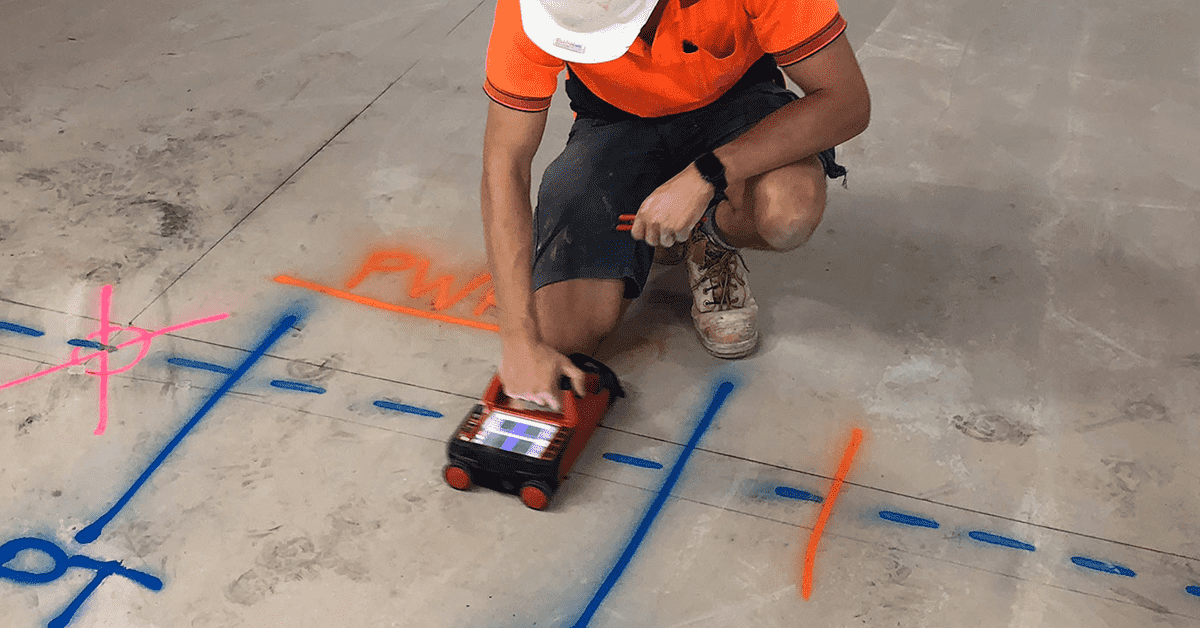Discovering the Key Benefits of Concrete Scanning in Building Projects
In the realm of modern-day construction practices, the application of concrete scanning innovation has arised as a critical device for ensuring task efficiency and architectural stability. From boosting precaution to properly finding utilities concealed beneath the surface area, the advantages of concrete scanning are diverse. The ability to simplify project timelines and lower costs while protecting existing frameworks is a testament to the worth this innovation offers the building sector. As we explore the nuanced advantages of concrete scanning, it becomes evident that its effect expands much beyond surface-level evaluations, supplying a glimpse right into the detailed web of advantages waiting to be revealed.
Improved Safety And Security Actions
Utilizing sophisticated concrete scanning innovation enhances precaution on building sites by offering precise discovery of prospective dangers concealed below the surface. This modern technology allows construction teams to identify rebar, avenues, post-tension cords, and other obstructions before excavation or exploration, substantially reducing the threat of mishaps. By identifying these elements specifically, employees can prevent destructive important architectural components, thus avoiding injuries, hold-ups, and expensive fixings.
Moreover, concrete scanning plays a vital function in making sure the stability of existing structures during restorations or expansions. By spotting weak points, gaps, or deterioration within concrete components, designers can address these issues proactively, enhancing the total security and durability of the building. This positive strategy not only minimizes the danger of architectural failures however additionally minimizes the potential for crashes triggered by unforeseen architectural shortages.
Basically, the application of concrete scanning technology acts as an aggressive security action that safeguards both building employees and the structural integrity of structures, ultimately adding to the general success and effectiveness of building and construction jobs. - RainierGPR Concrete Scanning
Accurate Detection of Energies
Concrete scanning innovation assists in accurate recognition of below ground energies, enhancing construction website security and effectiveness. Precise discovery of utilities is essential in construction tasks to stop expensive problems, task delays, and most notably, ensure the security of employees and the public. By using advanced scanning modern technologies such as ground-penetrating radar (GPR) and electromagnetic induction, building teams can draw up the place of hidden pipes, cables, and other utilities with high degrees of precision.

Time and Cost Efficiency

Concrete scanning modern technology makes it possible for construction groups to accurately situate rebar, post-tension cables, and other embedded objects within concrete structures. This accurate information helps in staying clear of costly blunders such as unexpected damage to crucial elements throughout exploration, reducing, or coring tasks. Furthermore, by recognizing prospective hazards in advance, the demand discover this info here for expensive repair work or rework as a result of problems can be reduced, bring about cost savings for the project.
Furthermore, the ability to quickly and precisely discover energies underneath the surface without creating any kind of damage not only conserves time but also stops expensive disturbances to existing facilities. On the whole, the moment and expense efficiency benefits of concrete scanning make it a very useful device for improving building job monitoring and implementation.
Conservation of Architectural Stability
Protecting the structural stability of structures and facilities is extremely important in making certain long-term stability and safety and security. Concrete scanning plays an important duty in this conservation procedure by allowing building experts to determine prospective risks to the architectural stability of a structure or facilities before they rise right into major problems. Via using innovative scanning modern technologies such as ground-penetrating radar (GPR) and electromagnetic induction, building groups can non-invasively examine the problem of concrete structures, situate rebar, post-tension cords, and various other ingrained aspects, and identify any type of voids, fractures, or degeneration within the concrete.
Improved Job Planning
In order to guarantee the successful implementation of building and construction tasks, precise interest to detail and comprehensive planning are important parts that stem from a comprehensive understanding of the structural problems recognized through concrete scanning. Improved job planning, helped with by concrete scanning, permits building teams to preemptively address prospective difficulties, designate sources extra efficiently, and establish realistic timelines. By precisely identifying the place of rebar, post-tension wires, and other embedded things within concrete structures, task managers can develop much more precise construction plans that lessen the danger of expensive mistakes or hold-ups. In addition, the information obtained from concrete scanning makes it possible for stakeholders to make enlightened decisions pertaining to architectural adjustments, improvements, or growths, causing smoother task shifts and improved general job results. Ultimately, integrating concrete scanning right into the job preparation stage improves sychronisation among employee, cultivates aggressive analytic, and adds to the successful delivery of building and construction tasks within budget and routine restrictions.
Conclusion
To visit conclude, concrete scanning supplies various advantages in building projects. By improving precaution, properly identifying energies, enhancing time and price effectiveness, protecting structural integrity, and assisting in task planning, concrete scanning confirms to be a vital device for effective task execution. Its ability to minimize dangers, boost effectiveness, and guarantee project stability makes it an indispensable asset for construction specialists.
In the world of modern-day construction practices, review the usage of concrete scanning innovation has arised as a pivotal tool for making sure task performance and structural honesty.Concrete scanning technology makes it possible for construction groups to precisely situate rebar, post-tension cords, and various other ingrained items within concrete structures. Via the use of innovative scanning technologies such as ground-penetrating radar (GPR) and electro-magnetic induction, building and construction teams can non-invasively assess the problem of concrete frameworks, situate rebar, post-tension cables, and other ingrained aspects, and identify any voids, cracks, or damage within the concrete.
In order to ensure the effective implementation of construction projects, careful attention to detail and thorough planning are necessary parts that stem from an extensive understanding of the architectural conditions recognized through concrete scanning. Ultimately, integrating concrete scanning into the task preparation stage enhances control amongst group members, cultivates proactive analytic, and contributes to the effective delivery of building tasks within spending plan and routine constraints.